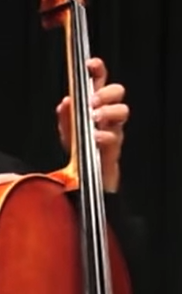Reaching New Heights!
Extensions are EVERYWHERE in cello music. Most beginner and intermediate cello music can be played with first position using forward and backward extensions. Once you are comfortable with forward and backward extensions, a whole new world of music is opened up to you. With forward extensions, you can now play in A major, D major, and G major. I always recommend doing the finger stretches exercise when learning the D major 2 octave, and A major 2 octave scales. Also checkout my lesson on backwards extensions which will add B-flat and F major to your toolkit.

When we extend forward to reach the note one half step above our current position, our first finger stays in position while the rest of the hand extends downward one note or tape. Second finger is then where third finger normally sits. Third finger goes where fourth finger normally sits, and fourth finger is now sitting one half step above the notes we could previously reach in the non-extended position. Extensions can be an uncomfortable stretch for many cellists. This exercise is designed to develop both the correct motion, which supports the pinkie, but also the flexibility you need to reach extended notes comfortably.

As with so many elements of cello technique the secret to success lies with our elbows and thumbs. If you suffer from a low elbow on your left side then extensions will be more awkward for you. The left elbow should be out like a kickstand, propped out enough to allow a good amount of air underneath the armpit. If the elbow sinks next to the body then the left thumb usually starts to angle up to become more parallel with the neck instead of perpendicular. The combination of a low elbow and a parallel thumb will make extending more uncomfortable and restricts the important thumb motion we need to support the pinkie.
Pro Tip
Protect the pinkie! Our 4th finger is the smallest, weakest finger and yet is often called upon to do more than its share of the work. Your 1st finger is super strong by comparison so move the thumb away from 1st finger to support 4th. Pros often shift to avoid playing long notes or heavily vibratoed notes on 4th finger to save the wear and tear on the pinkie.
If you do this exercise 10 times a day for 10 days you will find that your extensions become much more comfortable, flexible, and strong. I recommend doing this exercise in conjunction with the 2 octave D major scale or 2 octave A major scale, really any scale that requires extensions. Throughout your cello journey if you ever struggle with an extension, and we all do, try to remember this finger-stretching exercise and check in with your thumb. Chances are, you extended your fingers but left your thumb behind not supporting the 4th finger.
